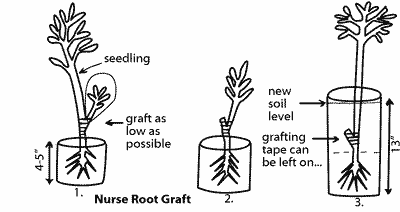
UPDATE ON DELAYED INCOMPATIBILITY WITH GRAFTED FRUIT TREES
I wrote an article on this subject which appeared in September/October 1996 Rare Fruit magazine 'The Exotics' No 100. At the time, I thought some people in the nursery industry may be offended but they were not. Just recently Peter Young from Birdwood Nursery talked about the same problem affecting the citrus (worst of all the dreadful Trifoliata suckering). I am referring to 'Australian Horticulture' of August/September 2001. I am very happy that someone else is noticing the problem and is doing something about it.
One may ask why, if grafting is so troublesome, do we do it. First of all, we can guarantee that the grafted tree will produce fruit, and if the selection is good, the fruit may be the best of thousands of seedling trees. All types of fruiting trees go through this selection process, this providing us with such good stone fruit, pears, apples, citrus etc.
Since 1966, I have found that a few more fruit trees prefer the nurse root graft. (Editor's note - a nurse root graft is where the tree is planted with the graft below ground level as per illustration.) I will list these and give you the reason for each.
First of all I would like to bring to your attention some of the plants which have latex in them which will benefit from the nurse graft - lucmo, ross sapote, star apple and mundu (yellow mangosteen).
With normal grafting, lucmo, ross sapote and star apple have much smaller fruit than the parent tree but with the nurse grafting, larger fruit will be produced. Although mundu grafts well by normal grafting methods, it may produce larger fruit by the nurse root graft because it is in the latex category.

For the last one hundred years or so, many people have tried to graft mangosteen. I started 25 years ago and unsuccessfully tried all sorts of rootstock in the mangosteen family. (Looking back on it now, I am sure the further one moves from the grafting species, the less chance there is of success. That seems to be the golden rule. However, there are a few exceptions, as with all golden rules - citrus, okari nut, stone fruits and custard apple).
At present I have twelve fruit trees on the Limberlost fruit list on which I use nurse root graft - avocado, custard apple, governor's plum, white sapote, duku, kaffir lime, yellow grumichama, durian, giant lucmo, mundu, ross sapote, star apple.
Growing avocado on the tropical coast is a real problem, with only a few varieties producing fruit. I selected a few seedling trees which have good fruit and bear heavily. I use nurse root grafts on them to improve the health and life span of the trees.
Governor's plum root stock can have very nasty thorns, so it is preferable to place the graft below ground level. White sapote and duku are very slow to grow when grafted, but with the root graft, they seem to be much faster and healthier.
I also use root graft on some citrus, mainly kaffir lime which produce good healthy growth. Kaffir lime will also grow from cuttings, but with difficulty.
Even with the nurse root graft, yellow grumichama will sucker to some extent. However, the yellow fruit is so unusual it is worth putting up with the suckering. Persistent cutting of the underground suckers and the mounding up of soil will eventually overcome the suckering.
Finally, the biggest problem - the king of fruit, the durian. Nothing seems to work well. Marcotting seems to be the best way, but it is very troublesome. Budding and approach grafting are also successful to some degree, as long as the graft finishes up below soil level as soon as possible. Most durian plants grafted that way form roots above the graft within six months. So it is time to ask the question - does all this rood grafting produce bigger trees? Yes, it does. But here is an easy pruning method which I have used for years at the nursery and at home which can be done at any time of the year. Ringbark the top of the trees or the leading branches to a width of 50 to 100 mm. It will take 1 to 3 years for the branches to fall out, depending on the hardness of the wood.
Best of all, the tree will not get sunburned and split the bark. This is very important with durian, but other trees also suffer from the effect of severe pruning. I found this method very easy, and the trees keep fruiting as it is happening, sometimes even above the ringbark. In strong winds, the tree usually breaks at the ringbark so the pruning is done for you.
I wish you all joy in your home grown fruit for many years to come.
DATE: August 2001
* * * * * * * * * * * * * * *
